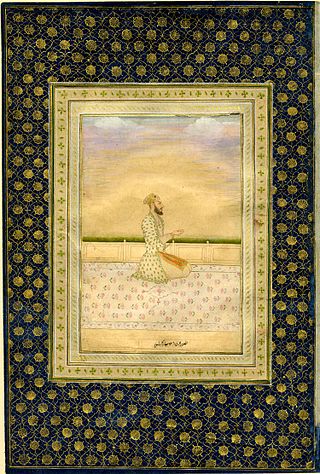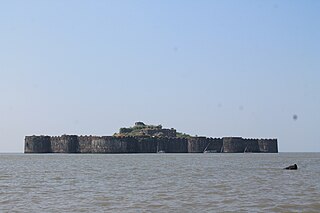Related Research Articles

Bajirao I was the 7th and greatest Peshwa of the Maratha Confederacy. He, after Chhatrapati Shivaji, is considered to be the most charismatic and dynamic leader in Maratha history. He was just twenty years old and already had a reputation for rapid decisions and a passion for military adventure.

Sambhaji, also known as Shambhuraje, was the second Chhatrapati of the Maratha Kingdom, ruling from 1681 to 1689. He was the eldest son of Shivaji, the founder of the Maratha Kingdom. Sambhaji's rule was largely shaped by the ongoing wars between the Marathas and the Mughal Empire, as well as other neighbouring powers such as the Abyssinians of Janjira, Wadiyars of Mysore and the Portuguese Empire in Goa. After Sambhaji's execution by Aurangzeb, his brother Rajaram I succeeded him as the next Chhatrapati and continued the Mughal–Maratha Wars.

Burhanpur is a historical city in the Indian state of Madhya Pradesh. It is the administrative seat of Burhanpur District. It is situated on the north bank of the Tapti River and 512 kilometres (318 mi) northeast of city of Mumbai, 340 kilometres (211 mi) southwest of the state's capital city of Bhopal. The city is a Municipal Corporation.

Balaji Vishwanath Bhat was the first of a series of hereditary Peshwas hailing from the Bhat family who gained effective control of the Maratha Confederacy and other Mughal vassals during the early 18th century. Balaji Vishwanath assisted a young Maratha king Shahu to consolidate his grip on a kingdom that had been racked by civil war and persistently intruded on by the Mughals under Aurangzeb. He was called the Second Founder of the Maratha State. He secured a grant from the Mughal court that confirmed Shahu as the legitimate Mughal vassal, at the expense of his rival Sambhaji II. Later, his son Bajirao I became the Peshwa.
The Mazagaon Fort was a British fort in Mazagaon, Bombay, in the Indian state of Maharashtra, built around 1680. The fort was razed by the Muslim Koli general, Yakut Khan in June 1690. The fort was located at the present-day Joseph Baptista Gardens, atop Bhandarwada Hill outside the Dockyard Road railway station.

Murud-Janjira is the local name of a famous fort and tourist spot situated on an island just off the coastal town of Murud, in the Raigad district of Maharashtra, India. Malik Ambar is credited with the construction of the Janjira Fort in the Murud Area of present-day Maharashtra India. After its construction in 1567 AD, the fort was key to the Sidis withstanding various invasion attempts by the Marathas, Mughals, and Portuguese to capture Janjira.

Malik Ambar was a military leader and statesman who served as the Peshwa of the Ahmadnagar Sultanate and its de facto ruler from 1600 until his death in 1626.
Murud is a town and a municipal council in Raigad district in the Indian state of Maharashtra. Situated at a distance of 150 km (93 mi) from Mumbai, Murud is a tourist destination. The Palace of Nawab is located in Murud. The palace was built in 1885 for administration purposes. The palace is still owned by the descendants of the Nawab and is a private property.
Mercenaries in India were fighters, primarily peasants, who came from India and abroad, to fight for local rulers in India in the medieval period. This mercenary work became an important source of income for some communities.

The Sachin State was a princely state belonging to the Surat Agency, former Khandesh Agency, of the Bombay Presidency during the era of the British Raj. Its capital was in Sachin, the southernmost town of present-day Surat district of Gujarat State.
The Patil is a title used by Koli chiefs of villages in Maharashtra.
Rander is a town in Surat district in the state of Gujarat, India. Located on the bank of the Tapti River, it is 2 kilometres (1.2 mi) from the city of Surat.

Muhammad Bidar Bakht was a Mughal prince. His father, Muhammad Azam Shah, briefly reigned as Mughal emperor in 1707. Bidar was noted for being a gallant, skilful and successful general and was regarded as the most able Mughal prince of his time. He was the favourite grandson of Emperor Aurangzeb.
Shahar Banu Begum was Empress consort of the Mughal Empire from 14 March 1707 to 8 June 1707 as the third wife of Emperor Muhammad Azam Shah. She is popularly known by the titles Padishah Bibi and Padshah Begum.

Janjira State was a princely state in India during the British Raj. It was governed by the Siddi Khan dynasty of Habesha descent and the state was under the suzerainty of the Bombay Presidency.

The Maratha Navy was the naval wing of the armed forces of the Maratha Confederacy, which existed from around the mid-17th century to the mid-18th century in the Indian subcontinent.

The Raja Ram Rao Patil or Itbarrao Koli was an Admiral of the Ahmadnagar Navy and Koli ruler of Janjira. Patil built and fortified the Janjira Island.

The Siege of Janjira was a military campaign undertaken by the Maratha Confederacy, commanded by Sambhaji, the second Maratha ruler, against the Siddis of Janjira in January 1682. The Maratha forces, led by Sambhaji, withdrew from Janjira to the Konkan region in response to Mughal attacks, leaving a contingent behind under the command of Dadaji Raghunath Deshpande. Despite their efforts, the Marathas were unable to capture the fort, and the Siddis pursued the retreating forces, plundering Maratha territories.

The Shivaji's invasions of Janjira were a series of military campaigns launched by the first Maratha ruler, Shivaji, against the Abyssinian rulers of the sea fortress of Janjira named Siddis between 1661 and 1676. The Marathas attacked the Janjira fort annually, and during the final siege of 1676, the Maratha Peshwa Moropant faced a counterattack by the Siddis, forcing the Marathas to retreat with heavy casualties.
References
- ↑ The African dispersal in the Deccan: from medieval to modern times, By Shanti Sadiq Ali, Published by Orient Blackswan, 1996,Public Domain, ISBN 81-250-0485-8, ISBN 978-81-250-0485-1
- ↑ The Indian Historical Quarterly (see page 234). Ramanand Vidya Bhawan. 1985.
- ↑ Palsokar, R. D.; Reddy, T. Rabi (1995). Bajirao I: an outstanding cavalry general. Reliance Pub. House. ISBN 9788185972947.
- ↑ Ali, Shanti Sadiq (1996). The African Dispersal in the Deccan: From Medieval to Modern Times. Orient Blackswan. ISBN 9788125004851.
- 1 2 3 4 Purnima Mehta Bhatt (2017). The African Diaspora in India Assimilation, Change and Cultural Survivals (ebook). Taylor & Francis. ISBN 9781351373654 . Retrieved 6 March 2024.
- ↑ John McLeod; Kenneth X. Robbins (2008). African Elites in India Habshi Amarat (Hardcover). Mapin. pp. 180–181. ISBN 9781890206970 . Retrieved 6 March 2024.
- ↑ History: Mediaeval period. Directorate of Government Printing, Stationery and Publications, Maharashtra State. 1967. p. 259. Retrieved 6 March 2024.
- ↑ Mohd. Ilyas Quddusi (2002). Khandesh Under the Mughals, 1601-1724 A.D. Islamic Wonders Bureau. p. 36. ISBN 9788187763215 . Retrieved 6 March 2024.
- ↑ Durgesh Narpat Valvi (2012). Kumar, K Pradeep (ed.). A Study of the Impact of Welfare Measures on Tribal Development in Nandurbar and Dhule Districts of Maharashtra. Shivaji University. p. 95. hdl:10603/139341 . Retrieved 6 March 2024.
- ↑ Radhey Shyam (1981). The Kingdom of Khandesh. Idarah-i-Adabiyat-i Delli. pp. 95, 107. Retrieved 6 March 2024.
- 1 2 3 Yimene, Ababu Minda (2004). An African Indian Community in Hyderabad: Siddi Identity, Its Maintenance and Change. Cuvillier Verlag. p. 204. ISBN 978-3-86537-206-2.
- ↑ State), Bombay (India (1883). Gazetteer of the Bombay Presidency ... Government Central Press.
- ↑ Ali, Shanti Sadiq (1996). The African Dispersal in the Deccan: From Medieval to Modern Times. Orient Blackswan. ISBN 9788125004851.
- ↑ Faruki, Z. (1935). Aurangzeb & his times. Idarah-i Adabiyāt-i Delli.
- ↑ Gyan Prakash (February 2009). "5". In Ranganathan, Murali (ed.). Govind Narayan's Mumbai An Urban Biography from 1863 (ebook). Anthem Press. p. 113. ISBN 9780857286895 . Retrieved 25 November 2023.
- 1 2 Nandgaonkar, Satish (22 March 2003). "Mazgaon fort was blown to pieces – 313 years ago". Indian Express . Express Group. Archived from the original on 12 April 2003. Retrieved 20 September 2008.
- ↑ Prakash, Om (1987). European Commercial Enterprise in Pre-colonial India. Cambridge University Press. ISBN 978-0-521-25758-9.
- ↑ Europe, 1450 to 1789: Encyclopedia of the Early Modern World
- ↑ Growth under the Mughals India Muslims: Who Are They?